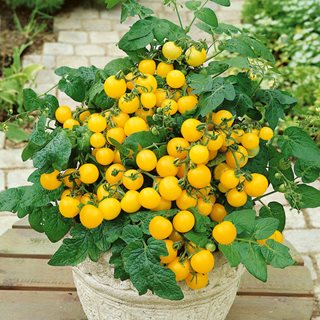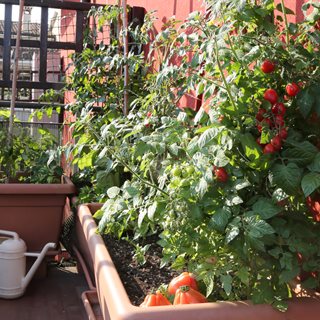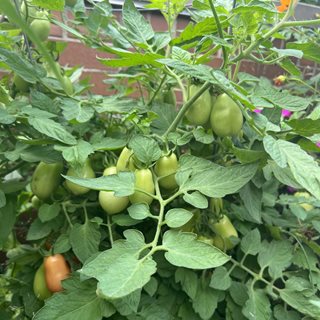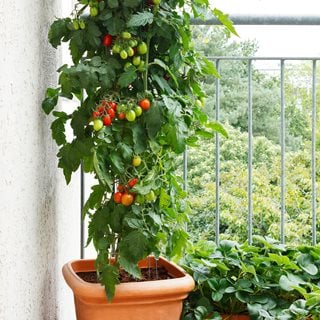How to Grow Tomatoes in Pots
Grow this tasty summertime treat even if you have limited spaceTomatoes are one of the most popular food crops to grow, and for good reason. This fruit or vegetable is one of the most versatile for preparing, cooking, and eating in salads, sauces, and other prepared dishes. The taste of homegrown tomatoes is far superior to store-bought, making the effort to grow your own fresh tomatoes highly rewarding.
Even if you live in an apartment or condo, or have a tiny urban lot, you can still grow tomatoes on a balcony, porch, or patio. All you need are large pots, lots of sun, good soil, water, and fertilizer. Here are some tips on how to grow tomatoes in pots.
On this page: Types | Soil | Containers | Planting | Care | Common Problems | FAQ's
On this page:
BEST TYPES OF TOMATOES FOR POTS
There are hundreds of different tomato varieties, which are classified into three types: indeterminate, determinate, and semi-determinate.
- Indeterminate tomatoes have a vining habit, continuing to grow throughout the season and setting fruit over a relatively long period of time.
- Determinate tomatoes have a compact bushy habit and stop growing when they reach their mature size, with fruit ripening in a narrow time frame.
- Semi-determinate types make up a smaller percentage of tomato varieties, have a compact habit, and also produce fruit over a relatively long period of time.
Determinate and semi-determinate types are better choices, as they will stay more compact. You can also grow indeterminate types if pots are big enough and there is room for plants to climb.
There are also dwarf and patio varieties especially bred for containers and hanging baskets—look for the terms “bush,” “patio” or “dwarf” on the plant label or seed description.
Some of the best tomato varieties to grow in containers include:
- Slicers, sauce, or salad tomatoes: ‘Bush Beefsteak’, ‘Bush Early Girl’, ‘Celebrity’, ‘Garden Gem’, ’Patio’, ‘Roma’
- Cherry tomatoes: ‘Micro Tom’, ’Patio Choice’, ‘Patio Sunshine’, ‘Small Fry’, ‘Tiny Tim’, ‘Tumbler’
Check out these care & growing tips from Bethany @chicagogardener.
BEST POTTING SOIL FOR TOMATOES
Tomatoes plants grow quickly and need good soil for optimal development. Garden soil is unsuitable for pots, as it is too heavy and will become compacted, restricting the flow of water and nutrients to plants. It can also contain soil-borne diseases and pests that can be harmful to tomato plants.
Potting mix or potting soil is lighter, containing ingredients such as perlite and peat moss to improve drainage, allowing water and nutrients to flow freely to plant roots. To get the most out of your potted tomato plants, choose a high quality all-purpose potting soil or mix.
BEST POTS FOR GROWING TOMATOES
Tomatoes develop large vigorous root systems and need to be planted in larger pots to perform their best. The minimum sized container for growing tomatoes should be able to hold 5 gallons of soil and measure 12 inches wide and deep, though bigger is better.
Tomato pots can be made of plastic, fiberglass, ceramic, terra cotta, wood, metal, or stone. Terra cotta pots will need more frequent watering, as they dry out more quickly. Black plastic or metal pots may absorb too much heat, causing plant stress. A 5-gallon plastic bucket commonly sold in hardware stores is a budget-friendly option (just be sure to add drain holes).
Make sure containers have adequate drainage holes in the bottom. Place containers on pot feet if they are sitting on a patio or other non-porous surface that hinders water from draining out of the bottom.
Containers can be placed on heavy duty planter caddies so you can turn or move plants around to take advantage of the best light.
HOW TO PLANT TOMATOES IN POTS
Tomato plants can be grown from seed or nursery-grown starts.
When planting tomatoes in pots, wait until night time temperatures are consistently above 55 degrees F to plant outdoors.
Mix a balanced slow-release fertilizer into the soil, or choose one that’s especially formulated for vegetables or tomatoes. Use according to package instructions. Bone meal may also be added to boost calcium, which can help stem blossom end rot, a common tomato disease.
Remove tomato plant from its starter cell or nursery pot and tease out roots if potbound.
Dig a hole in the soil. Place tomato plant below soil level to allow roots to develop along the stem. This will encourage a more developed root system, resulting in a stronger, healthier plant. The stem can be buried up to the first set of leaves. Fill in the hole with soil, gently tamp down to remove air pockets, and water thoroughly.
Add a layer of mulch such as straw, shredded bark, chopped leaves, or compost around the base of plants to help cool the roots, retain moisture and suppress weeds.
HOW TO CARE FOR TOMATOES IN POTS
Light: Tomatoes are sun and heat lovers that need at least 6 to 8 hours of direct sun throughout the growing season. Choose a sunny balcony, porch, patio, or deck for your containers.
Space: Make sure there is adequate space around pots so that air can circulate freely. This will help prevent diseases.
Water: Tomato plants require lots of water, especially once they get bigger and develop an extensive root system. Tomatoes in pots dry out more quickly than those in the ground, so will need to be watered more often. Follow these tips:
- Keep plants evenly moist and don’t allow soil to dry out. Avoid overwatering to prevent root rot or other diseases. Uneven watering may cause blossom end rot.
- Water slowly and deeply, allowing water to percolate completely into the soil. Keep watering until water comes out the bottom of the container. More frequent lighter waterings will cause shallow root development and weak plants.
- During prolonged heat or dry spells, plants will likely need to be watered once or twice a day.
- Water in early in the day to reduce evaporation and allow foliage to dry out, which will help prevent moisture-borne diseases.
- Water around the base of the plants and avoid splashing the foliage as much as possible, which can result in diseases.
Learn more about how to properly water tomato plants.
Fertilizing: Tomatoes are heavy feeders, needing lots of nutrients to support their rapid growth and high fruit yields. Plants grown in pots need more fertilization than those in the ground, as nutrients leach out more quickly with frequent watering. At the time of planting, add a balanced slow-release fertilizer to the soil according to instructions.
When plants begin flowering, supplement with a balanced liquid fertilizer such as fish emulsion, seaweed or compost tea every two weeks.
Support: Stems that are heavy with fruit can bend or break without adequate support. At the time of planting, place a tomato cage or stake in the pot to give plants support and keep them from flopping over. Read more on how to stake tomato plants.
Pruning: For indeterminate types, remove suckers in the crotch between the side branches and primary stem. Suckers do not produce fruit and take energy away from fruit-bearing branches. Avoid pruning determinate bush types, as you may be cutting off fruit-bearing branches. Remove lower leaves touching the soil to help prevent soil-borne diseases. Read more on how to prune tomato plants.
COMMON PROBLEMS WITH TOMATOES IN POTS
When growing tomatoes in pots, look for signs of these common problems:
To correct overwatering, allow soil to dry out, inspect soil to see if it’s overly compacted, and check drainage holes in the bottom of the container for possible blockage. If you suspect root rot, dig out the plant, remove wet soil from around the roots, cut out unhealthy or damaged roots, and repot in fresh soil.
Too little water can cause stunted plant growth and lower crop yields. Symptoms include dry soil, wilted, curled, yellow, or brown leaves with a dry, crispy texture; failure to flower or dropped flowers, blossom end rot, fruit drop, or smaller fruit.
To determine whether your tomato plants are getting enough water, stick your finger down into the soil. If it feels dry to the touch 2 inches down, it’s time to water. Check plants once or twice daily during heat or dry spells. Remove dead or damaged foliage. Make sure there aren’t factors hindering water absorption, such as a top crust on the soil or soil compaction.
Under-fertilization can result in stunted growth and lower crop yields. Because containers have limited soil space and are watered more frequently, fertilizers will leach out of the soil more quickly. Make sure to follow a regular fertilizing schedule.
Over-fertilization can result in too much leafy growth at the expense of flowers and fruit, or cause fertilizer burn, yellow leaves, stunted growth, lack of fruit, or damaged fruit. To correct the problem, stop fertilizing plants immediately. Flush soil to dilute the concentration of nutrients. Make sure to use the proper kind of fertilizer and resume a regular fertilizing schedule.
Small containers may result in plants becoming root bound, stunted growth, watering issues, and smaller yields. Remove plant from container and check the root ball. If your tomato plant looks root bound, transplant to a larger sized pot.
Too little sunlight can result in stunted growth, few or no flowers, smaller yields, and fruit that is not properly ripened. Though your spot may receive full sun during the peak of summer, it’s important to make sure tomatoes gets 6 to 8 hours of sun throughout their life cycle. Determine the amount of sun exposure your site gets before planting. If the light shifts to more shade, move containers to a sunnier spot.
Read more about tomato disease and pest problems.
FAQ'S
Should I water tomatoes in pots every day?
Frequency of watering depends on the temperature, air humidity, and container size. During extreme hot or dry spells, containers will likely need watering once, or even twice a day. Check to see if soil is dry before watering.
Do tomatoes prefer deep or wide pots?
Deeper pots help plants to establish a healthy root system.
How deep do containers need to be for tomatoes?
Containers should be at least 12 inches deep, though deeper is better.
How many tomatoes can you put in a 5-gallon bucket or container?
Tomatoes develop an extensive root system and need as much room to grow as possible. Regardless of container size, you should only place one tomato plant in each pot.
Are used coffee grounds good for tomato plants?
Coffee grounds contain nutrients such as nitrogen and phosphorus that are essential for healthy plant growth. Using coffee grounds around plants is a controversial subject with a range of opinions. If you decide to place coffee grounds around your tomato plants, do so sparingly. The safest way to use coffee grounds in your garden is to mix them into your compost pile and allow them to break down with the other ingredients. Read more on using coffee grounds in your garden.
RELATED:
Container Garden Ideas




